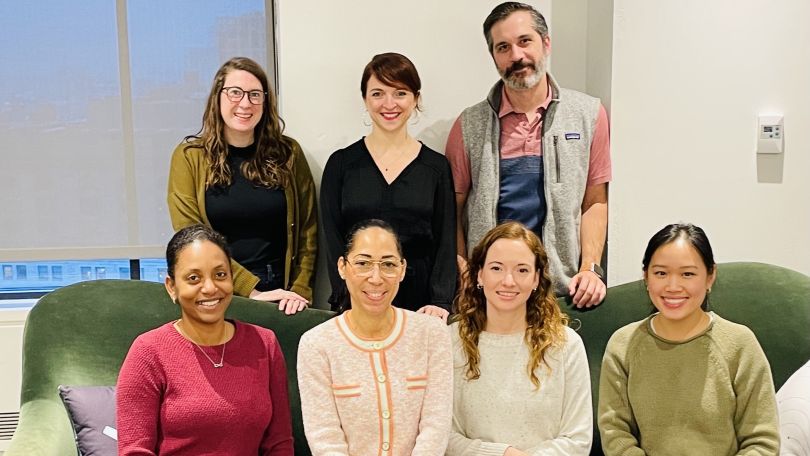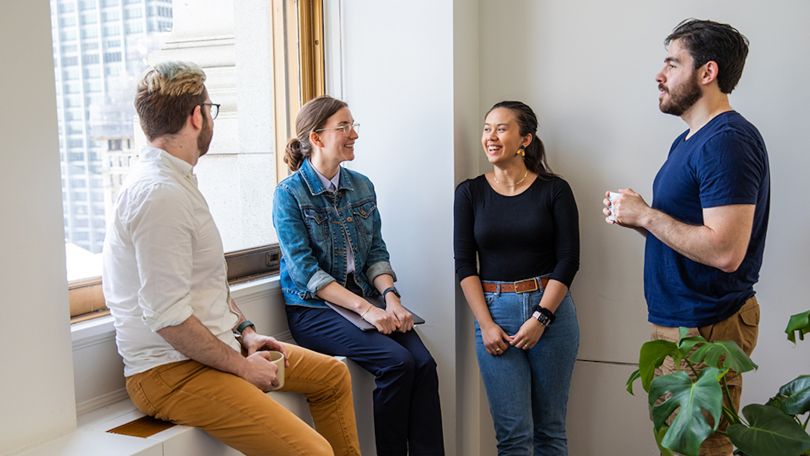“If you want to build a ship, don’t drum up the men to gather wood, divide the work, and give orders. Instead, teach them to yearn for the vast and endless sea,” writer and pioneering French aviator Antoine de Saint-Exupéry once wrote.
The best leaders will not be found in ivory towers, sequestered from those they lead and insulated from criticism and fresh perspectives. Like the sentiment in Saint-Exupéry’s words, leadership demands individuals who empathetically tap into the interests and forces that energize and motivate their teams.
But recent surveys point more toward the former leadership style than the latter.
According to a February 2023 Gallup survey, only 33 percent of respondents said somebody had talked to them about their progress in the last six months. Meanwhile, only 30 percent strongly agreed that they had received recognition for their work in the last seven days.
At six New York City companies, leaders who serve a range of teams keep colleagues engaged and imbue purpose in everyday work by creating opportunities for connection, experimentation and growth. They shared how they do it.

AdTech company Integral Ad Science specializes in digital ad verification, ensuring ads are viewed by real people in the right environments. The company is driven by real-time data that provides actionable insights and signals.
Describe one of the principles, habits or rituals that differentiates your unique approach to leadership. What is it? When did you start doing this?
I foster a culture of empowerment, inclusion and diversity. This will manifest itself in many ways.
I build diverse teams with varied experiences, perspectives and backgrounds that will drive innovation and creativity. I give my team a high-level roadmap of our goals, give them the tools and resources they need, and then empower them to use their unique skills and competencies to get there.
I insist on an inclusive environment where everyone on the team feels valued, respected and, most importantly, empowered to contribute and voice their opinions and ideas. I provide equal opportunities for growth and development for all team members. I adapt my management style to be inclusive of the needs, preferences and strengths of my individual team members.
What differences did you notice after you adopted this new principle, habit or ritual in your leadership?
There have been some significant noticeable differences:
Increased engagement and motivation help employees feel empowered, included and present. With autonomy and decision-making capabilities, I have noticed that the team has a great sense of ownership in their work.
We have definitely experienced higher levels of innovation and creativity. By providing strong encouragement for employees to voice their ideas and opinions, we have unlocked a greater potential from the team.
By providing strong encouragement for employees to voice their ideas and opinions, we have unlocked a greater potential from the team.”
A greater sense of collaboration and teamwork. With every opinion heard, we have created an environment with a common goal and high levels of collaboration.
Better problem-solving is a byproduct of collaboration; by bringing people from diverse backgrounds and with diverse skills together and giving them the tools they need, I have witnessed much stronger solutions from the team.
What does this approach to leadership help you and your teams accomplish?
In short, I would say that this approach to leadership drives better outcomes. By leveraging the unique strengths and perspectives of each team member and promoting a culture of teamwork and collaboration, I am empowering the team to take ownership and accountability for their work. This freedom drives better outcomes and results for IAS.
Healthtech company Cedar is on a mission to improve the billing experience by guiding healthcare consumers through a personalized journey backed by data science and interactive design.
Describe one of the principles, habits or rituals that differentiates your unique approach to leadership. What is it? When did you start doing this?
One of the main principles of my leadership is to always listen to the ideas of my entire team and allow them to execute or support the execution of their ideas if they fit within the team’s goals and priorities. Transparently, I received upward feedback during a review that my team wanted to feel more included in the creation of our goals, so I thought about how to solicit ideas more proactively. That’s why in December 2021, I implemented an end-of-quarter retro for the entire team to participate in, regardless of level. I ask them how they think we can execute our team vision, what went well, what could have gone better and what we should consider doing the next quarter.
Transparently, I received upward feedback during a review that my team wanted to feel more a part of creating our goals, so I thought about how to solicit ideas more proactively.”
At the same time, I also make sure I’m setting realistic expectations that some ideas may not always fit our team’s priorities or be surfaced at the right time to be executed — but are valued nonetheless. We won’t have time for everything, and not all ideas can be part of our official quarterly goals, but often smaller projects, new processes or team events will come out of the feedback from a session. The feedback trends that surface, coupled with making people feel heard and appreciated, are invaluable.
What differences did you notice after you adopted this new principle, habit or ritual in your leadership?
The feedback from the first session was very positive! My team enjoyed brainstorming together and being pushed to think about what makes the team as a whole successful. We’ve had some great efforts and projects come out of it too. For example, team members wanted to upskill in SQL and Looker.
The idea of having a team member more experienced in those areas conduct a teaching session or boot camp arose during one of these retros. We acted on that idea, which allowed one team member to hone in on their project planning and presentation skills and allowed the rest of the team to acquire more of the skills they were seeking. Additionally, concerns about how to get support from more senior members of the team surfaced, which led to the creation of team office hours and an official escalation queue.
What does this approach to leadership help you and your teams accomplish?
As a team, it keeps us aligned and cohesive and adds to our already very supportive team environment. It encourages everyone to feel like they have a stake and say in the team’s overall success and direction. At the individual level, it allows everyone on the team to feel heard and encourages thinking critically and sometimes outside the box. It also helps them grow as professionals by giving them unique tasks and projects to execute that are sometimes a bit outside of their daily standards. I am very proud of my team at Cedar and their commitment to our success and accomplishments!
VTS is a commercial real estate technology platform that is a first-party data source in the industry, delivering insights and solutions that guide investment strategy, leasing and marketing automation, property management and tenant experience.
Describe one of the principles, habits or rituals that differentiates your unique approach to leadership. What is it? When did you start doing this?
I don’t have one. Maybe not trying to have one is unique? I genuinely believe that times change, people change and businesses change, so you should never be fixed on any one ideology or philosophy.
What differences did you notice after you adopted this new principle, habit or ritual in your leadership?
I’m new to my role, but I feel I’m finally starting to hear what people care about, find interest in and aspire to. I have someone on my team who was super forthcoming that they wanted more sales exposure and more national exposure. They were so enthusiastic and heads-down about their current role that I may have missed that.
I’m new to my role, but I feel I’m finally starting to hear what people care about, find interest in and aspire to.”
What does this approach to leadership help you and your teams accomplish?
With no set ethos, my hope is our team can move as one while appreciating each other’s differences and really strive for excellence.
That may sound like a lot of jargon, but those are actually some of our core principles as a company, and I want my team to act those out in a way that makes them feel uniquely heard.
That’s what drives innovation and customer service in the long run.
Movable Ink, one of Built In’s Best Places to Work for four consecutive years, is a platform that transforms data into personalized content and helps brands accelerate their marketing performance.
Describe one of the principles, habits or rituals that differentiates your unique approach to leadership. What is it? When did you start doing this?
One of my favorite parts of leadership is being able to implement solutions to complex challenges. It’s easy to look at a challenge and gravitate towards the quickest fix, which often is the fix that would produce immediate results but won’t be sustainable in the long run. I’ve cultivated a habit where when faced with a problem, I work with my team to brainstorm what the ideal solution would be if time, budget and resources weren’t a constraint. From there, we brainstorm. Working backward from the ideal solution to determine the two to three paths that we could take to achieve that solution, helps my team and I collectively focus on the end goal instead of the quick fix — and has been a transformative way to solve challenges that arise.
What differences did you notice after you adopted this new principle, habit or ritual in your leadership?
My team and I became less reactive and more strategic. Before implementing the habit of working backward from the end goal, we had a tendency to want to solve challenges quickly and move on to the next. What we found was that the same challenge would crop up time and time again when the quick solution that we’d implemented was no longer appropriate in a quickly changing environment. Taking stock of our approach to problem-solving and focusing on sustainable, long-term solutions allowed us to work collaboratively with internal stakeholders to implement workflows that could scale with us instead of us quickly outgrowing them.
Taking stock of our approach to problem-solving and focusing on sustainable, long-term solutions allowed us to work collaboratively with internal stakeholders.”
What does this approach to leadership help you and your teams accomplish?
It helps us envision what we want our team and our team’s achievements to look like six months or one year down the line and work toward those goals instead of focusing on how we can maximize results only in the short term. Looking at sustainable and scalable solutions also helps us align our team-specific goals with company-wide KPIs to focus on meaningful growth over time. It’s easy to get distracted by all the competing priorities that crop up in the workplace, but using this approach to problem-solving gives me and my team the ability to ensure that we always have the end goal — the ideal state — in mind and we’re always striving towards that.

ActionIQ is a Customer Experience (CX) hub situated in the customer data platform category. Organizations like The Washington Post, Bloomberg and Morgan Stanley leverage ActionIQ’s CX Hub to deliver great customer experiences.
Describe one of the principles, habits or rituals that differentiates your unique approach to leadership. What is it? When did you start doing this?
As a leader, one of my guiding principles is authenticity. For many years I thought being a leader meant you had to only show your perceived strengths and that vulnerability was a sign of weakness. I made a deliberate decision several years ago to let my team see me as a real, authentic human being. This involves practicing a measured level of vulnerability with my team about my thoughts, feelings and challenges. I want my team to understand that while we have high standards for performance, I do not expect perfection. I expect people to be human, and we are, by definition, imperfect. True teamwork means doing our best both individually and collectively. This is difficult to do if we feel like we must constantly put on a facade.
What differences did you notice after you adopted this new principle, habit or ritual in your leadership?
I noticed that communication and collaboration within the team improved. Trust and psychological safety also seemed to increase. I was able to build strong relationships with most of my team members. We work through challenges together, and from what I’ve observed, they have strong bonds with each other. Personally, I felt lighter and had more mental space to get things done. I was able to better collaborate with my own peers.
We work through challenges together, and from what I’ve observed, they have strong bonds with each other. I felt lighter and had more mental space to get things done.”
What does this approach to leadership help you and your teams accomplish?
I believe this approach helps us to be high-performing teams. Authentic leadership leads to increased trust, psychological safety, improved communication, collaboration and team cohesion. All of these benefits further lead to resilience, high engagement and productivity. These are all key elements of high-performing teams, and I continually look forward to the work we’re able to accomplish together.

Orchard is a real estate technology company which enables homesellers to buy their new home before they sell, harness real estate, mortgage and title services in one place, and access local agents and price-boosting options.
Describe one of the principles, habits or rituals that differentiates your unique approach to leadership. What is it? When did you start doing this?
As a leader, I think it is really important to give your teams a full understanding of the business context. They need to understand not only what the goals are but also why those are the goals, how I think about them and what appetite we have for experimentation. Once you have a shared understanding of that, then you can empower your teams to suggest the best solutions and projects for the business and make sure they have the right resources and organizational alignment to be successful.
I started doing this early in my career as a manager after reflecting on my own experiences with good and bad managers and what differentiated them. One gap I saw is that junior folks tend to have a better understanding of the tactics and the best way to implement something but often don’t have access to all of the business context and the broader view of tradeoffs that more senior people do. Some of my managers tried to solve this by micromanaging; this method frustrated me because I felt like their suggestions weren’t the best way to execute. A better process is to bring people in on the context so that they can be equipped to make the best recommendations.
What differences did you notice after you adopted this new principle, habit or ritual in your leadership?
Teams feel more bought in when they understand the rationale behind business goals and decisions and can recommend better decisions and projects to move those goals forward. I also found that explicitly discussing our appetite for experimentation and failure made team members more comfortable in suggesting bigger bets that had the potential to move the needle forward on business results.
Teams feel more bought in when they understand the rationale behind business goals and decisions and can recommend better decisions and projects to move those goals forward.”
For example, we forecast marketing channel spend and cost per lead for our paid marketing teams, and our paid team is held to those goals. This could lead to a sense of risk aversion — people wouldn’t want to try things that could hurt results or might be too quick to turn off a test that had poor early data. Explicitly discussing what portion of our spend we were comfortable putting towards testing and what kind of results we would expect — and that we were okay with them being worse — led to a higher volume of suggestions from the team, many of which were larger in scope with the potential for more impact. These suggestions could vary from a new product experience for people landing on our website to testing out a new marketing channel like influencer marketing.
What does this approach to leadership help you and your teams accomplish?
This approach has helped my teams accomplish more for the business and learn faster by creating a culture of educated experimentation.
For example, we decided to make an investment in SEO after a proposal was created by a team member. We knew this is typically a more speculative, longer-term investment that takes time to see results, and we were explicit with both the working group and the leadership team about what kind of metrics we expected to see early on — which were low. While it did take time, within a year, we quickly outpaced our initial expectations, growing SEO traffic 10 times.
On the flip side, an example of something we didn’t end up scaling was our influencer marketing. This was also a proposal raised by a team member who saw an opportunity to use an influencer’s credibility with their audience since buying and selling a home requires a lot of trust. We did see some promising early results but ultimately found it difficult to scale since
Orchard only operates in certain markets, eliminating a significant percentage of any influencer’s audience as customers. However, the findings led us to think about more ways we could use endorsements that did have a local audience.
















